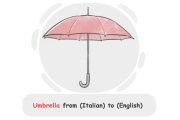Loan Words and Calque
In this lesson you will learn how loan words and calques bring new words or phrases from other languages into English. Practice with examples and exercises to improve your understanding.

What is a Loan Word?
A loan word is a word that is borrowed from one language and used in another language, often with little or no modification in spelling or pronunciation.
Loan-Words: Types
There are two types of loan words:
Foreign words with the same spelling: a word is borrowed from a foreign language and its orthography stays the same.
Umbrella from (Italian) to (English)
espresso from (Italian) to (English)
pasta from (Italian) to (English)
Café from (French) to (English)
crepe from (French) to (English)
Ski from (Norwegian) to (English)
Bazaar from (Persian) to (English)


Foreign words with different spelling: In this case the orthography of the word changes in the target language.
Chofer (Spanish) from (French) chauffeur
Futbal (Hungarian) from (English) Football
sˇekki (Finnish) from (English) check
Tip
Other languages like French borrow English words as well, like 'stress' or 'cool'.
What Is Calque?
A calque is a word or phrase in one language that is formed by directly translating the meaning or structure of a word or phrase from another language. Calques are also known as loan translations.
Calque: Types
Phraseological calque: when idiomatic phrases or sets of expressions are translated word by word.
'It goes without saying' (English) tranlated from 'ça va sans dire' (French)
In this example, ça = it, va = goes, sans = without, dire = saying
'schau stehlen' (German) translated from 'steal the show' (English)
Syntactic calque: Syntactic or structural calque is the product of an inexact connection between the elements of a sentence or phrase.
to find guilty = encontrar culpable (instead of ''declarar culpable'') from Spanish to English.
Here, a third language is made which could be called 'Spanglish'.
Semantic calque: Additional meanings of the words in the source language are transferred to the word in the target language, with the same primary meaning.
Biergarten (German) = beer garden (English)
Here, the concept of 'beer garden' is derived from German.
Computer mouse (English) = souris (French)
Hot dog (English) = perros calientes (Spanish)
Gratte-Ciel (French) = scrape-sky (English)
Marché aux puces (French) = flea market (English)
Phonological calque: When the pronunciation of a word is imitated in the other language.
radar (English) = léidá (similar-sounding Chinese word)
Here, this word literally means "to arrive (as fast) as thunder"
teflon (English) = Tiě fú lóng (similar-sounding Chinese word)
Typographic calque: When typographical rules in the source language are transferred to the new language. For example, the rule of capital letters in English has started to enter into Spanish, as well as the use of italics for emphasis and certain uses of quotation marks.
She was just talking to her.
Here, we must use italics for emphasis.
My favorite magazine is New York Times.
As you can see, the name of newspapers and magazines must be written in italics.
Comments
(0)